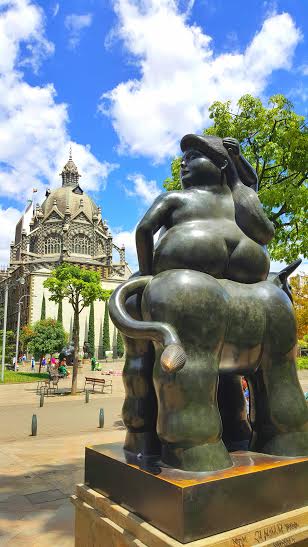By Bart Barry

Editor’s note: For part 10, please click here.
*
BOGOTA, Colombia – This Andean city hasn’t Medellin’s organization or courtesy but a more amiable climate and what inherent formality nations’ capitals enjoy by default. The distance from here to Medellin, Colombia’s second most-populous city, is about 400 km, a distance whose impossibility of terrain is best illustrated like this: You can fly there in 30 minutes of airtime or drive there in about 480 minutes. The cities’ populations regard one another more like motorists than aeronauts, each describing the residents of the other city the way a Californian might describe a Russian, not an Arizonan.
Colombians are known for their eloquence, which may be why nearly every Colombian one encounters, however briefly, fancies himself a Spanish professor, correcting tiny details of pronunciation and grammar other native speakers, whether Mexican or Argentine or even Spanish, cordially overlook. That quickness to correct, though, betrays pride more than arrogance; no one’s face illuminates more grandly when hearing a stranger’s high appraisal of his country than a Colombian’s.
For nearly two decades synonymous with every ill effect of the narcotics trade, today Colombia, far surpassed in reports of narcoterrorism by Mexico, experiences an overdo cultural renaissance sure to be followed in time by what tourism tracks rumors of inexpensive exotica – something Colombia does excessively well. Nothing holds constant in a complex adaptive system, of course, so Colombia’s rebirth will eventually bring maturity and stagnation and perhaps a mortal return to whence it came, sure, but in the interim it merits celebration for what it is in the present, and that is a lovely, hospitable place to visit. And anyone who reviews the history of South America, 1510-1810, the singular depravity of the Spanish conquest, realizes without delay how miraculous are tranquil moments like the ones Colombia currently enjoys.
Touristland, the world over, is the same place: “La zona roja” in Medellin could be Las Vegas could be Puerto Vallarta. Time in Touristland, a place of ennui nearly always removed from the messy vitality of its city’s heart, if not its base, renews nothing so much as one’s commitment to not-travel where he is not conversant in the language of its people.
Whether via an iPhone app or a stereotypical and incessantly repeated plea for “anyone here speak English”, persons who travel to places whose languages they do not speak miss much of the most-edifying part of travel, and that is navigation. When you do not speak the language you go where the authorities direct you, whether those authorities are guides or signs or tourist-friendly maps. You make inane requests of locals for “someplace no tourists ever go” – as if any sane local would send a tourist to foul somewhere he goes to escape tourists. There is a visual part of travel that can be satisfied without speaking any language but English – museums and natural artifacts and monuments and such – and those shouldn’t be discounted, but the people and their quirks and their personal versions of their countries’ histories, every bit fallible as your opinion of your country’s history, are where the greatest riches are mined. These riches, too, include the natives’ true opinions of your country, not the cliched “ees bery nice, my fren” spouted mindlessly at customers, but the sort of attentive criticism that provides what contrasts compose the meaningful stock of a durable identity, often far removed from fragile patriotic delusions.
We don’t know what we don’t know, and few things are more futile than chancing the argument above: Those who travel the world with U.S. passports and a command of only English do so under the conviction they are seeing the highlights of each place they visit – nine countries in eight days! – and that conviction is both unshakeable and leavened by their financial means, invariably greater than many of their countrymen’s, as well as a large majority of Americans unfit to challenge them for being bereft of even a current passport. But this is a column that may opine as it wishes; if you have a dissenting opinion on the matter, a witty and original thought you feel compelled to share, write your own column.
About the museums in Colombia: native son Fernando Botero dominates the original works both at Museo Botero in this city and Museo de Antioquia in Medellin, as he should. To create original art after 1950, many painters abandoned form, using instead muscular color and abstraction. Botero did not. Instead, he took common subjects, many borrowed from historic pieces by everyone from Leonardo to Matisse, and made them voluptuous to make them sensuous. He complemented these voluminous subjects with the brilliant greens and oranges one encounters everywhere he looks in these mountainous cities of extraordinary biodiversity.
The irony is that Botero’s exaggerated forms are the most part of what the world imagines Colombians’ physiques to be. In Bogota and Medellin, two cities where daily commutes happen on foot and require a half hour’s climb to nearly any residential spot, this is not at all the case. Pound-for-pound, the “Rolos” and “Paisas” are some of the fittest folks you’ll encounter anywhere, their diets unpolluted by corn syrup, their lungs expanded by high altitudes, and their lower bodies sculpted by daily acts of ascent and descent. One does not encounter many handicap ramps or elevators, either, so one subsequently encounters octogenarians stomping right past him as he scales this city’s Calle 11, lungs screaming for more or at least thicker air . . .
*
Editor’s note: For part 12, please click here.
*
Bart Barry can be reached via Twitter @bartbarry










